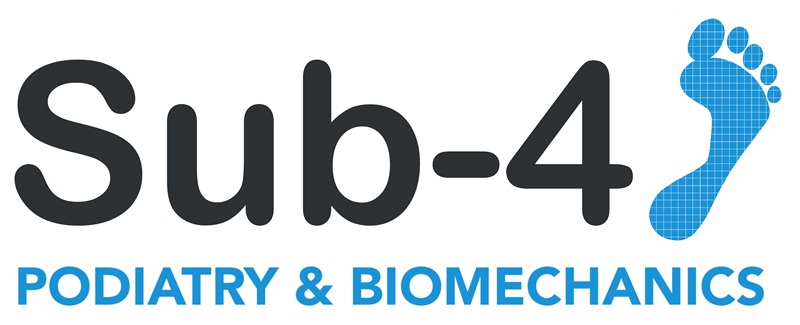Shin Splints
Sub-4 Musculoskeletal Biomechanics Clinic in Staffordshire, West Midlands
Shin Splints
Shin Splints, are medically known as medial tibial stress syndrome. Shin splints often occur in athletes who have recently intensified or changed their training regime. This increased activity overworks the muscles, tendons and bone tissues.
There are two types of Shin splints;
Anterior Shin Splints (Anterior tibial stress syndrome ATSS)
Anterior shin splints are located on the shinbone’s front (or anterior) that involve the use of the tibialis anterior muscle. The tibialis anterior lifts and lowers your foot. It lifts your foot during the swing phase of a stride and lowers your foot in preparation for the support phase.
If your anterior shin pain increases when lifting your toes while keeping heels on the ground, you will likely suffer from anterior shin splints.
Posterior Shin Splints (Medial tibial stress syndrome (MTSS)
Posterior shin splints are located on the inside back (or medial/posterior) part of the shinbone and involve the tibialis posterior muscle. The tibialis posterior lifts and controls the medial aspect of your foot arch, especially during the weight bearing support phase. When your tibialis posterior is weak and lacks muscle endurance, your foot arch collapses, creating torsional shin bone stresses.
If you feel pain along the inside rear of your shin bone, you will likely be suffering from either posterior shin splints or tibia stress fractures.
Shin Splints
Shin Splints are medically known as medial tibial stress syndrome. Shin splints often occur in athletes who have recently intensified or changed their training regime. This increased activity overworks the muscles, tendons and bone tissues.
There are two types of Shin splints;
Anterior Shin Splints (Anterior tibial stress syndrome ATSS)
Anterior shin splints are located on the shinbone’s front (or anterior) that involve the use of the tibialis anterior muscle. The tibialis anterior lifts and lowers your foot. It lifts your foot during the swing phase of a stride and lowers your foot in preparation for the support phase.
If your anterior shin pain increases when lifting your toes while keeping heels on the ground, you will likely suffer from anterior shin splints.
Posterior Shin Splints (Medial tibial stress syndrome (MTSS)
Posterior shin splints are located on the inside back (or medial/posterior) part of the shinbone and involve the tibialis posterior muscle. The tibialis posterior lifts and controls the medial aspect of your foot arch, especially during the weight bearing support phase. When your tibialis posterior is weak and lacks muscle endurance, your foot arch collapses, creating torsional shin bone stresses.
If you feel pain along the inside rear of your shin bone, you will likely be suffering from either posterior shin splints or tibia stress fractures.
Shin Splints – Signs & Symptoms
Anterior Shin Splints (Anterior tibial stress syndrome ATSS)
- If your anterior shin pain increases when lifting your toes while keeping heels on the ground, you will likely suffer from anterior shin splints.
Posterior Shin Splints (Medial tibial stress syndrome (MTSS)
- If you feel pain along the inside rear of your shin bone, you will likely suffer from either posterior shin splints or tibia stress fractures.
Diagnosis
The best way to know if you are suffering from Shin Splints or there are no underlying conditions causing the pain, is to Book a free assessment with Sub-4 clinic.
The assessment will help to look at the pain and check if it is Shin Splints and decide which is the best way to achieve recovery.
Shin Splints – Treatment & Cost
The purpose of a Sub-4 free assessment, is to help explore the pain issue you have and determine what (if anything) can be done to treat your Shin Splints. A Biomechanical Assessment level can be discussed as well, depending on the level of pain or discomfort you are suffering.
Shin Splints – Pain in your Shins?
Don’t ignore the problem
TELEPHONE: 01782 551698
VISIT SUB-4 CLINIC ON FACEBOOK
Your Recovery… is Our Mission!
We can help you get to the underlying cause of your pain.
Connect with us
MON – FRI: 9:00am -5:00pm
SAT: 8:00am – 12:00
SUN: Closed

